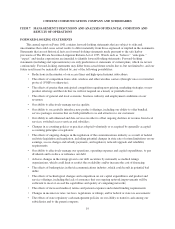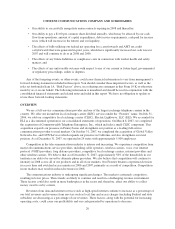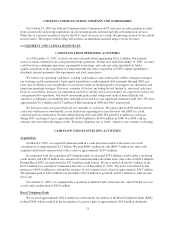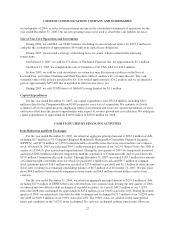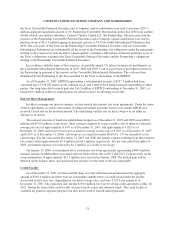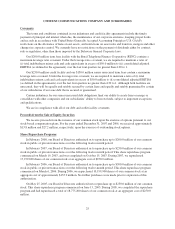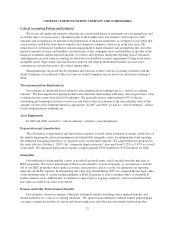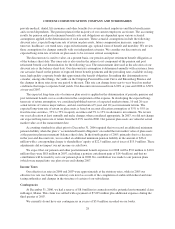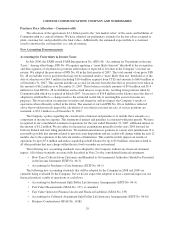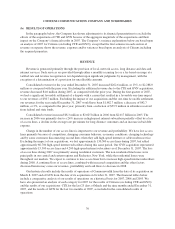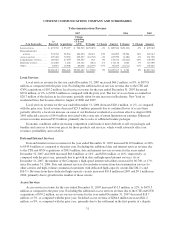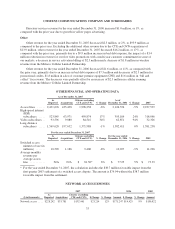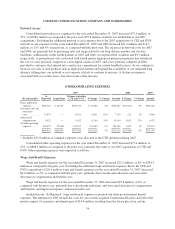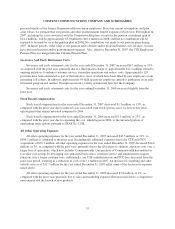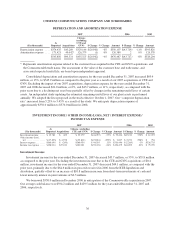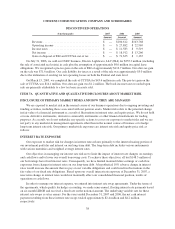Frontier Communications 2007 Annual Report Download - page 32
Download and view the complete annual report
Please find page 32 of the 2007 Frontier Communications annual report below. You can navigate through the pages in the report by either clicking on the pages listed below, or by using the keyword search tool below to find specific information within the annual report.CITIZENS COMMUNICATIONS COMPANY AND SUBSIDIARIES
provide medical, dental, life insurance and other benefits for covered retired employees and their beneficiaries
and covered dependents. The pension plans for the majority of our current employees are frozen. The accounting
results for pension and post retirement benefit costs and obligations are dependent upon various actuarial
assumptions applied in the determination of such amounts. These actuarial assumptions include the following:
discount rates, expected long-term rate of return on plan assets, future compensation increases, employee
turnover, healthcare cost trend rates, expected retirement age, optional form of benefit and mortality. We review
these assumptions for changes annually with our independent actuaries. We consider our discount rate and
expected long-term rate of return on plan assets to be our most critical assumptions.
The discount rate is used to value, on a present basis, our pension and post retirement benefit obligation as
of the balance sheet date. The same rate is also used in the interest cost component of the pension and post
retirement benefit cost determination for the following year. The measurement date used in the selection of our
discount rate is the balance sheet date. Our discount rate assumption is determined annually with assistance from
our actuaries based on the pattern of expected future benefit payments and the prevailing rates available on long-
term, high quality corporate bonds that approximate the benefit obligation. In making this determination we
consider, among other things, the yields on the Citigroup Pension Discount Curve and Bloomberg Finance and
the changes in those rates from one period to the next. This rate can change from year-to-year based on market
conditions that impact corporate bond yields. Our discount rate increased from 6.00% at year-end 2006 to 6.50%
at year-end 2007.
The expected long-term rate of return on plan assets is applied in the determination of periodic pension and
post retirement benefit cost as a reduction in the computation of the expense. In developing the expected long-
term rate of return assumption, we considered published surveys of expected market returns, 10 and 20 year
actual returns of various major indices, and our own historical 5-year and 10-year investment returns. The
expected long-term rate of return on plan assets is based on an asset allocation assumption of 35% to 55% in
fixed income securities, 35% to 55% in equity securities and 5% to 15% in alternative investments. We review
our asset allocation at least annually and make changes when considered appropriate. In 2007, we did not change
our expected long-term rate of return from the 8.25% used in 2006. Our pension plan assets are valued at actual
market value as of the measurement date.
Accounting standards in effect prior to December 31, 2006 required that we record an additional minimum
pension liability when the plan’s “accumulated benefit obligation” exceeded the fair market value of plan assets
at the pension plan measurement (balance sheet) date. In the fourth quarter of 2005, primarily due to a decrease
in the year-end discount rate, we recorded an additional minimum pension liability in the amount of $36.4
million with a corresponding charge to shareholders’ equity of $22.5 million, net of taxes of $13.9 million. These
adjustments did not impact our net income or cash flows.
We expect that our pension and other postretirement benefit expenses for 2008 will be $5.0 million to $10.0
million (they were $8.8 million in 2007, excluding a pension curtailment gain of $14.4 million) and that no
contribution will be made by us to our pension plan in 2008. No contribution was made to our pension plans
(which were merged into one plan at year end) during 2007.
Income Taxes
Our effective tax rates in 2006 and 2007 were approximately at the statutory rates, while in 2005 our
effective tax rate was below the statutory rate level as a result of the completion of audits with federal and state
taxing authorities and changes in the structure of certain of our subsidiaries.
Contingencies
At December 31, 2006, we had a reserve of $8.0 million in connection with a potential environmental claim
in Bangor, Maine. This claim was settled with a payment of $7.625 million plus additional expenses during the
third quarter of 2007.
We currently do not have any contingencies in excess of $5.0 million recorded on our books.
28



